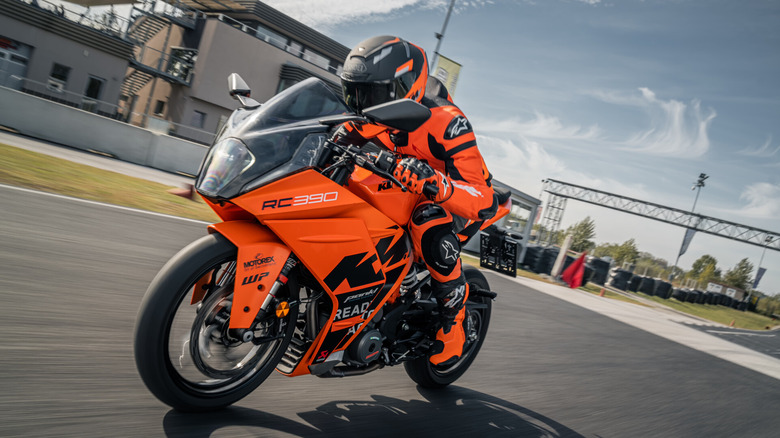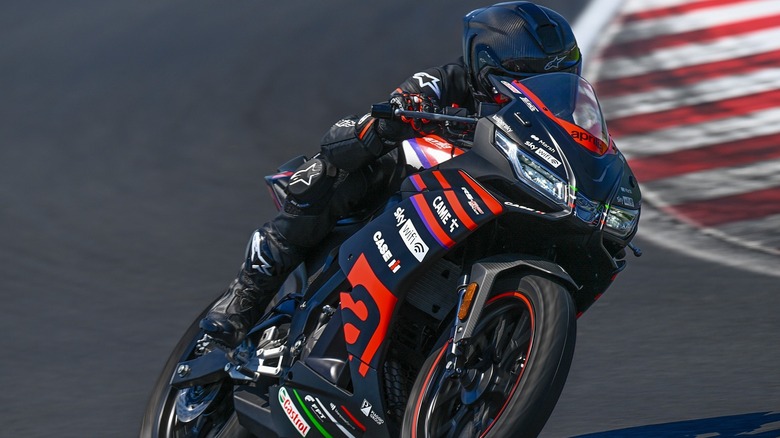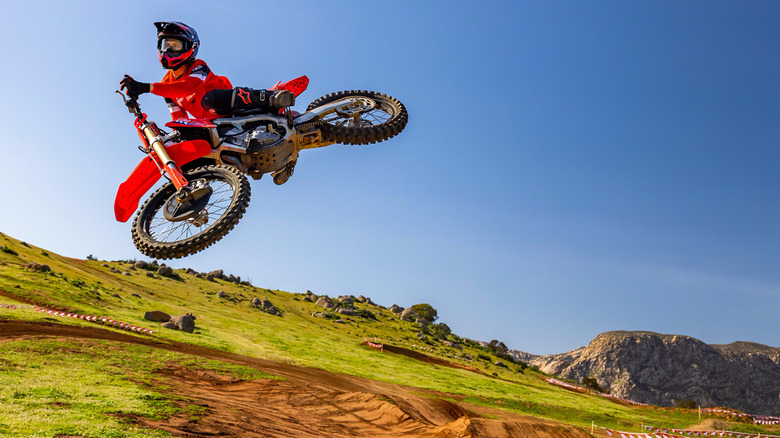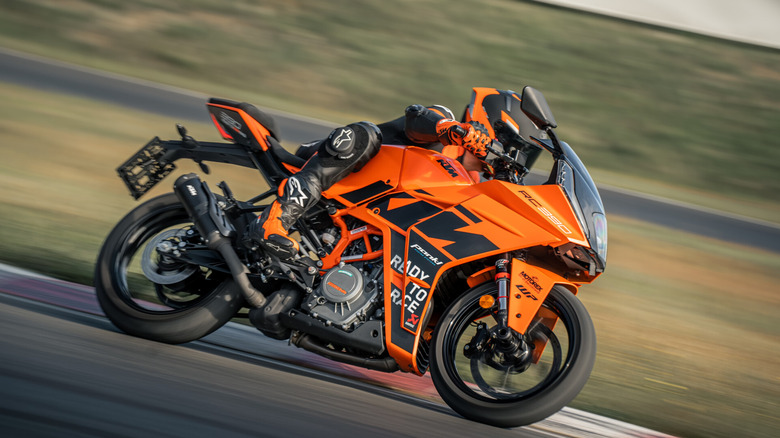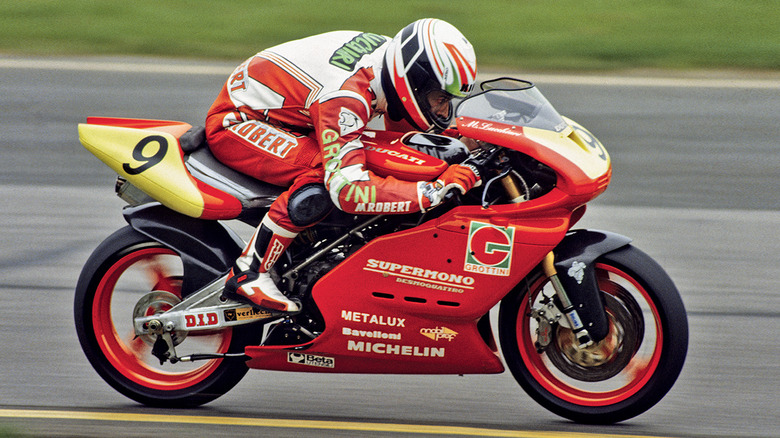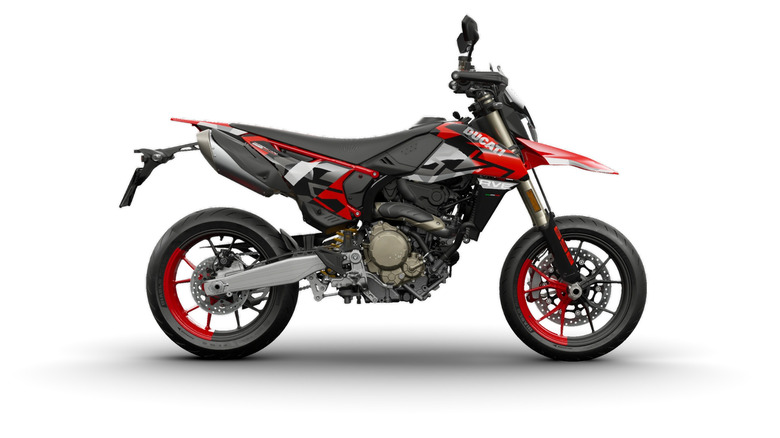5 Small Motorcycle Engines With Impressive Horsepower Output
Whether we're talking about vehicles with two or four wheels, a primary goal of engineers is to wring out as much power from each unit of displacement for every engine they make. This keeps weight down and efficiency up and is especially important in motorcycle design because it makes bikes easier to balance. Manufacturers like Harley-Davidson and its American rival Indian Motorcycle rely on large V-twin engines to move their bikes, and many of the models in Kawasaki's 2024 Ninja line have inline four-cylinder engines.
Some of the biggest engines ever used in motorcycles had as many as eight cylinders and were as sizable as those in many cars, but plenty of motorcycle makers have been able to produce surprising power from one-cylinder engines with relatively small displacements. We've looked through the catalogs of the top producers of two-wheeled machines to find the motors that have provided the most bang relative to their small sizes.
The Aprilia RS 125 is a MotoGP champion
In much of Europe, as long as you have a driver's license for cars, you don't need a motorcycle license to ride bikes with motors displacing less than 125 cubic centimeters. This makes the Aprilia RS 125 a popular bike in its class. It has a liquid-cooled one-banger that sits at 124.2 cubic centimeters, keeping it just under the 125cc limit. The RS 125 debuted in 1992 with a two-stroke motor, and Valentino Rossi rode one to the 125GP championship five years later.
Rossi dominated the circuit that year at age 18, in just his second year in the class. He won 11 out of the 15 races on the calendar and scored two more podium finishes. The RS 125 has gone through a few upgrades over the years, the biggest one being the move to a four-stroke engine in 2011.
A large number of the RS 125s sold to non-MotoGP racers had their motors restricted to 15 horsepower to keep them legal for young riders with learner licenses, but the RS 125's engine is capable of about twice that. The manufacturer claims a top speed of 93 miles per hour, but smaller riders might be able to eke out a little more than that by hiding behind the fairing.
The Honda CRF450R has been around for over 20 years
Honda has been making motorcycles since 1949. Its first bike, the Dream D, had a 98cc two-stroke motor, and Honda has continued that tradition of innovation in the decades since. The Super Cub's sales of over 100 million units makes it the best-selling motor vehicle in history, and Honda's motorcycle lineup also includes long-range baggers, sport bikes, and motocross machines.
That last category includes the CRF450R, a model that debuted in production form in 2002. It had an aluminum frame that kept the weight to under 250 pounds and a 450-cubic-centimeter engine that lent the model its name.
The 2025 model marks the seventh generation of the CRF450R, and Honda has continued to refine the bike's ride and powertrain throughout its run. Dirt Rider tested the CRF450R's newest liquid-cooled single-cylinder engine at 51.1 horsepower and 32.9 lb-ft of torque, and that outlet's Allan Brown said that power was put to the dirt smoothly. "It's now much more controllable and easier to use efficiently," he noted, "and I'm not constantly fighting to control the throttle while riding."
The KTM RC 390 is another race-bred monster
KTM makes some of the best-looking motorcycles on the market today, but they're not just pretty showpieces. The Austrian manufacturer has a strong racing pedigree across multiple formats, and much of that experience went into the design of the RC 390 and its 373-cubic-centimeter single-cylinder engine. It has impressive output numbers of 40.2 horsepower and 24.4 lb-ft of torque, which is plenty for a bike that weighs under 350 pounds without its rider.
The RC 390's four-stroke motor is more powerful than the 440-cubic-centimeter one-cylinder engine that sits at the heart of the Harley-Davidson X 440, a low-end bike that is currently only available in India. Despite being larger than the RC 390's by a full 50 cubic centimeters, the X 440's engine produces just 27 horsepower. Indian market customers also have access to the KTM RC 390 GP, a race-tuned version of that model with an engine that cranks out 43 horsepower and 27.3 lb-ft of torque.
The Ducati Supermono was made for the track only
Ducati motorcycles cost a pretty penny, but a large portion of that cost goes into the engineering of the motors that power the Italian-made bikes. Ducati's legacy was built on the racetrack, and one of its most potent engines went into a model that was made in very limited quantities and only for racing. The Supermono was designed by Pierre Terblanche, and its technical development was handled by Claudio Domenicali, who went on to become Ducati's CEO.
Only 67 Supermonos were built in the 1990s to compete in the European Supermono Championship, and Mauro Lucchiari won that title on a Ducati Supermono in 1993. The Supermono had a fuel-injected 549-cubic-centimeter single-cylinder engine that produced 75 horsepower and 38 lb-ft of torque. This engine was a modified version of Ducati's Desmoquattro V-twin, with a counterbalancing system in place of the second piston.
In 2009, British engineer Alistair Wager used the knowledge he acquired while working on 20 of the 67 original Supermonos to build a street-legal version he called the Supermono Strada. For his project, Wager borrowed the upper end from the 999's Testastretta motor, which increased displacement to 595 cubic centimeters and power output to 88 horsepower. The Frankenbike was completed using parts from other Ducati models and custom British-built frames, and Wager sold the Strada for 35,000 pound sterling. At the time, that was equivalent to roughly $52,000 in U.S. currency, but inflation makes that equal to about $78,000 today. That's still less than the cost of a Superleggera V4, Ducati's 234-horsepower beast.
Ducati's new Superquadro Mono makes 85 horsepower in race trim
Ducati's latest and greatest single-cylinder engine takes the tiramisu in terms of innovation and performance. Dubbed the Superquadro Mono, this 659-cubic-centimeter dynamo is capable of producing as much as 85 horsepower in race tuning with a performance exhaust, and torque output maxes out at a little over 46 lb-ft. The Superquadro Mono will be tamed a bit in production versions and will sit at the heart of the new Hypermotard 698 Mono.
The Superquadro Mono shares some elements with the Panigale's 1,285-cubic-centimeter two-cylinder engine, including a 116-millimeter-wide piston and large Desmodromic valves. The short stroke allows a redline of over 10,000 revolutions per minute, helping the Superquadro Mono crank out its whopping power numbers.
Fuel is fed to the cylinder via an oval-shaped throttle body with an equivalent diameter of 62 millimeters, and ride-by-wire control allows for precise delivery of fuel to the massive combustion chamber. The cylinder is made of aluminum to save weight and help dissipate heat, and the asymmetrical crankshaft has two countershafts to balance the engine and drive the oil and water pumps.
